Joint TDOA, FDOA and PDOA Localization Approaches and Performance Analysis
Abstract
:1. Introduction
2. Localization Scenario and CRLB
2.1. Localization Scenario
2.1.1. Localization Scenario for Precise Phase Synchronization
2.1.2. Localization Scenario for Phase Asynchronization
2.2. Derivation of CRLB
2.2.1. CRLB for Precise Phase Synchronization
2.2.2. CRLB for Phase Asynchronization
2.2.3. Comparative Analysis of CRLBs
3. Maximum Likelihood Estimator
3.1. Solutions for Phase Wrapping Problem
3.2. Iterative ML Estimation Algorithms
3.2.1. ML Estimator for Precise Phase Synchronization
3.2.2. ML Estimator for Phase Asynchronization
4. Simulations
4.1. Simulations for Phase Wrapping Solution
4.2. Solutions for Localization Algorithms
5. Conclusions
Author Contributions
Funding
Data Availability Statement
Conflicts of Interest
References
- Cater, G.C. Time Delay Estimation for Passive Sonar Signal Processing. IEEE Trans. Acoust. Speech Signal Process. 1981, 29, 462–470. [Google Scholar]
- Weinstein, E. Optimal Source Localization and Tracking from Passive Array Measurements. IEEE Trans. Acoust. Speech Signal Process. 1982, 30, 69–76. [Google Scholar] [CrossRef]
- Murata, M.; Ahmetovic, D.; Sato, D.; Takagi, H.; Kitani, K.M.; Asakawa, C. Smartphone-based Indoor Localization for Blind Navigation Across Building Complexes. In Proceedings of the 2018 IEEE International Conference on Pervasive Computing and Communications (PerCom), Athens, Greece, 19–23 March 2018; pp. 1–10. [Google Scholar]
- Fan, L.; Zhou, C. 3D Lightning Location Method Based on Range Difference Space Projection. Remote Sens. 2022, 14, 1003. [Google Scholar] [CrossRef]
- Yang, G.; Shi, X.; Feng, L.; He, S.; Shi, Z.; Chen, J. CEDAR: A Cost-effective Crowdsensing System for Detecting and Localizing Drones. IEEE Trans. Mobile Comput. 2019, 19, 2028–2043. [Google Scholar] [CrossRef]
- Wang, Y.; Zhou, T.; Yi, W.; Kong, L. A GDOP-Based Performance Description of TOA Localization with Uncertain Measurements. Remote Sens. 2022, 14, 910. [Google Scholar] [CrossRef]
- Sun, Y.; Ho, K.C.; Wan, Q. Solution and Analysis of TDOA Localization of a Near or Distant Source in Close Form. IEEE Trans. Signal Process. 2019, 67, 320–335. [Google Scholar] [CrossRef]
- Wang, Y.; Sun, G.-C.; Wang, Y.; Yang, J.; Zhang, Z.; Xing, M. A Multi-Pulse Cross Ambiguity Function for the Wideband TDOA and FDOA to Locate an Emitter Passively. Remote Sens. 2022, 14, 3545. [Google Scholar] [CrossRef]
- Wei, H.-W.; Peng, R.; Wan, Q.; Chen, Z.-X.; Ye, S.-F. Multidimensional Scaling Analysis for Passive Moving Target Localization with TDOA and FDOA Measurements. IEEE Trans. Signal Process. 2010, 58, 1677–1688. [Google Scholar]
- Sun, Y.; Ho, K.C.; Wan, Q. Eigenspace Solution for AOA Localization in Modified Polar Representation. IEEE Trans. Signal Process. 2020, 68, 2256–2271. [Google Scholar] [CrossRef]
- Vidal-Valladares, M.G.; Díaz, M.A. A Femto-Satellite Localization Method Based on TDOA and AOA Using Two CubeSats. Remote Sens. 2022, 14, 1101. [Google Scholar] [CrossRef]
- Jiang, X.; Li, N.; Guo, Y.; Yu, D.; Yang, S. Localization of Multiple RF Sources Based on Bayesian Compressive Sensing Using a Limited Number of UAVs With Airborne RSS Sensor. IEEE Sens. J. 2021, 21, 7067–7079. [Google Scholar] [CrossRef]
- Huang, S.; Wang, B.; Zhao, Y.; Luan, M. Near-field RSS-based Localization Algorithms Using Reconfigurable Intelligent Surface. IEEE Sens. J. 2022, 22, 3493–3505. [Google Scholar] [CrossRef]
- Foy, W.H. Position-localization Solutions by Taylor-series Estimation. IEEE Trans. Aerosp. Electron. Syst. 1976, 12, 187–194. [Google Scholar]
- Chan, Y.T.; Ho, K.C. A Simple and Efficient Estimator for Hyperbolic Localization. IEEE Trans. Signal Process. 1994, 42, 1905–1915. [Google Scholar] [CrossRef]
- Mikhalev, A.; Ormondroyd, R.F. Comparison of Hough Transform and Particle Filter Methods of Emitter Geolocalization Using Fusion of TDOA Data. In Proceedings of the 2007 4th Workshop Positioning, Navigation and Communication, Hannover, Germany, 22 March 2007; pp. 121–127. [Google Scholar]
- Bin, Y.Z.; Yan, Q.; Nan, L.A. PSO Based Passive Satellite Localization Using TDOA and FDOA Measurements. In Proceedings of the 2011 10th IEEE/ACIS International Conference on Computer and Information Science, Sanya, China, 16–18 May 2011; pp. 251–254. [Google Scholar]
- Wang, G.; Li, Y.; Ansari, N.A. Semidefinite Relaxation Method for Source Localization Using TDOA and FDOA Measurements. IEEE Trans. Veh. Technol. 2013, 62, 853–862. [Google Scholar] [CrossRef]
- Weiss, A.J. Direct Position Determination of Narrowband Radio Frequency Transmitters. IEEE Signal Process. Lett. 2004, 11, 513–516. [Google Scholar] [CrossRef]
- Weiss, A.J. Direct Geolocalization of Wideband Emitters Based on Delay and Doppler. IEEE Trans. Signal Process. 2011, 59, 2513–2521. [Google Scholar] [CrossRef]
- Li, J.; Yang, L.; Guo, F.; Jiang, W. Coherent Summation of Multiple Short-time Signals for DirectPositioning of a Wideband Source Based on Delay and Doppler. Digit. Signal Process. 2016, 48, 58–70. [Google Scholar] [CrossRef]
- Ma, F.; Liu, Z.-M.; Guo, F. Direct Position Determination for Wideband Sources Using Fast Approximation. IEEE Trans. Veh. Technol. 2019, 68, 8216–8221. [Google Scholar] [CrossRef]
- Ma, F.; Guo, F.; Yang, L. Direct Position Determination of Moving Sources Based on Delay and Doppler. IEEE Sens. J. 2020, 20, 7859–7869. [Google Scholar]
- Ho, K.C.; Lu, X.; Kovavisaruch, L. Source Localization Using TDOA and FDOA Measurements in the Presence of Receiver Localization Errors: Analysis and Solution. IEEE Trans. Signal Process. 2007, 55, 684–696. [Google Scholar] [CrossRef]
- Hmam, H. Optimal Sensor Velocity Configuration for TDOA-FDOA Geolocalization. IEEE Trans. Signal Process. 2017, 65, 628–637. [Google Scholar] [CrossRef]
- Elgamoudi, A.; Benzerrouk, H.; Elango, G.A.; Landry, R. Gauss Hermite H Filter for UAV Tracking Using LEO Satellites TDOA/FDOA Measurement—Part I. IEEE Access 2020, 8, 201428–201440. [Google Scholar] [CrossRef]
- Wolf, F.; Berg, V.; Dehmas, F.; Mannoni, V.; de Rivaz, S. Multi-Frequency Phase Difference of Arrival for Precise Localization in Narrowband LPWA Networks. In Proceedings of the ICC 2021—IEEE International Conference on Communications, Montreal, QC, Canada, 14–23 June 2021; pp. 1–6. [Google Scholar]
- Zhang, K.; Shen, C.; Bao, M.; Vaniushkina, D.; Kumushai, K.; Zang, L. Research on Optimization Algorithm Based on PDOA. In Proceedings of the 2021 IEEE 21st International Conference on Communication Technology (ICCT), Tianjin, China, 13–16 October 2021; pp. 1427–1430. [Google Scholar]
- Sippel, E.; Hehn, M.; Koegel, T.; Groschel, P.; Hofmann, A.; Bruckner, S.; Geiss, J.; Schober, R.; Vossiek, M. Quasi-Coherent Phase-Based Localization and Tracking of Incoherently Transmitting Radio Beacons. IEEE Access 2021, 9, 133229–133239. [Google Scholar] [CrossRef]
- Gashi, M.; Botler, L.; Koutroulis, G.; Diwold, K. Poster Abstract: Accurate and Efficient Hybrid Indoor Localization using ML Methods. In Proceedings of the 2022 21st ACM/IEEE International Conference on Information Processing in Sensor Networks (IPSN), Milano, Italy, 4–6 May 2022; pp. 523–524. [Google Scholar]
- Ma, Y.; Wang, B.; Pei, S.; Zhang, Y.; Zhang, S.; Yu, J. An Indoor Localization Method Based on AOA and PDOA Using Virtual Stations in Multipath and NLOS Environments for Passive UHF RFID. IEEE Access 2018, 6, 31772–31782. [Google Scholar] [CrossRef]
- Zhang, S.; Du, P.; Chen, C.; Zhong, W.-D.; Alphones, A. Robust 3D Indoor VLP System Based on ANN Using Hybrid RSS/PDOA. IEEE Access 2019, 7, 47769–47780. [Google Scholar] [CrossRef]
- Peng, C.; Jiang, H.; Qu, L. Deep Convolutional Neural Network for Passive RFID Tag Localization Via Joint RSSI and PDOA Fingerprint Features. IEEE Access 2021, 9, 15441–15451. [Google Scholar] [CrossRef]
- Chen, H.; Ballal, T.; Saeed, N.; Alouini, M.-S.; Ai-Naffouri, T.Y. A joint TDOA-PDOA localization approach using particle swarm optimization. IEEE Wirel. Commun. Lett. 2020, 9, 1240–1244. [Google Scholar] [CrossRef]
- Zhang, S.; Zhong, W.-D.; Du, P.; Chen, C. Experimental Demonstration of Indoor Sub-Decimeter Accuracy VLP System Using Differential PDOA. IEEE Photonics Technol. Lett. 2018, 30, 1703–1706. [Google Scholar] [CrossRef]
- Yeredor, A.; Angel, E. Joint TDOA and FDOA Estimation: A Conditional Bound and Its Use for Optimally Weighted Localization. IEEE Trans. Signal Process. 2011, 59, 1612–1623. [Google Scholar] [CrossRef]


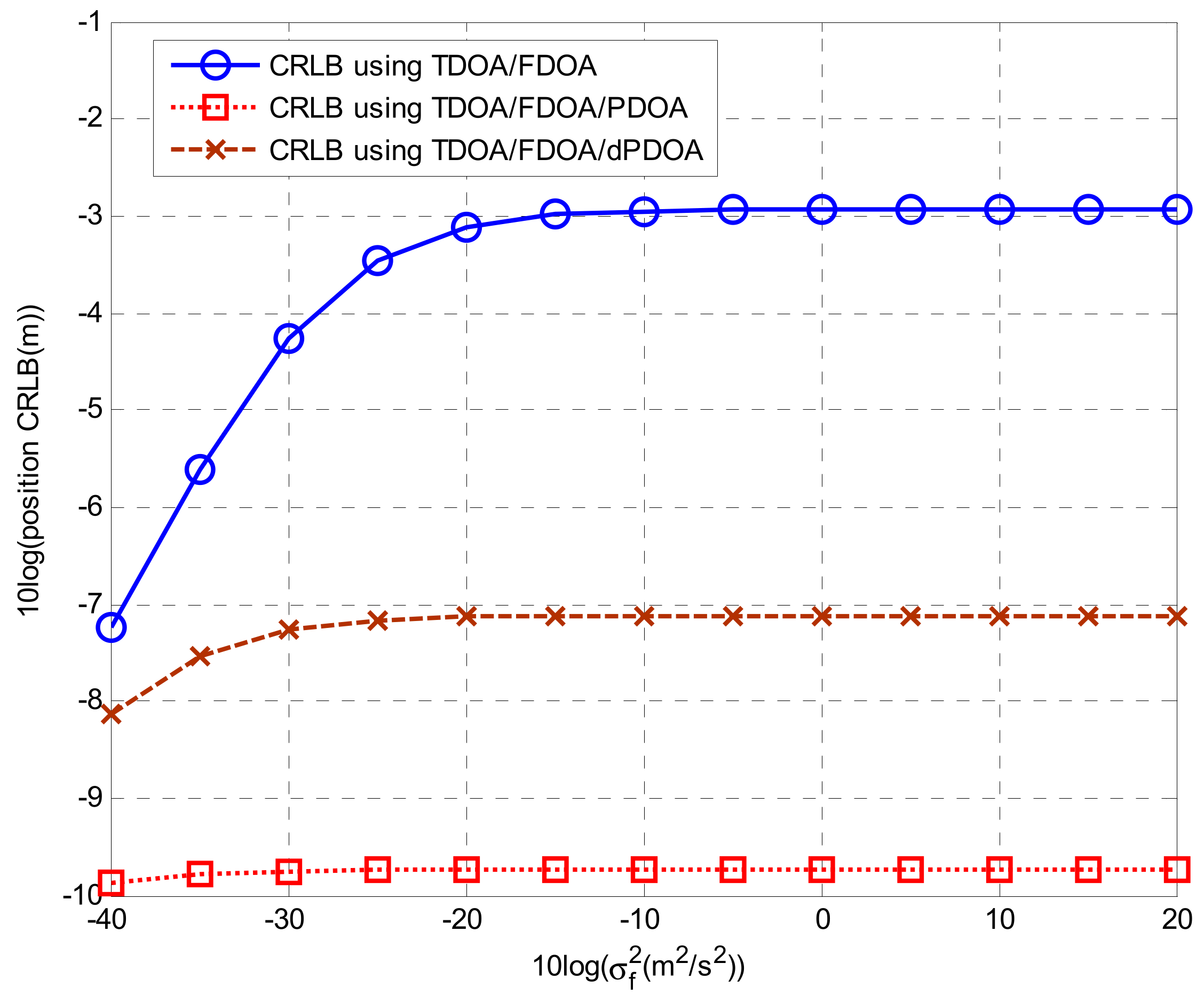

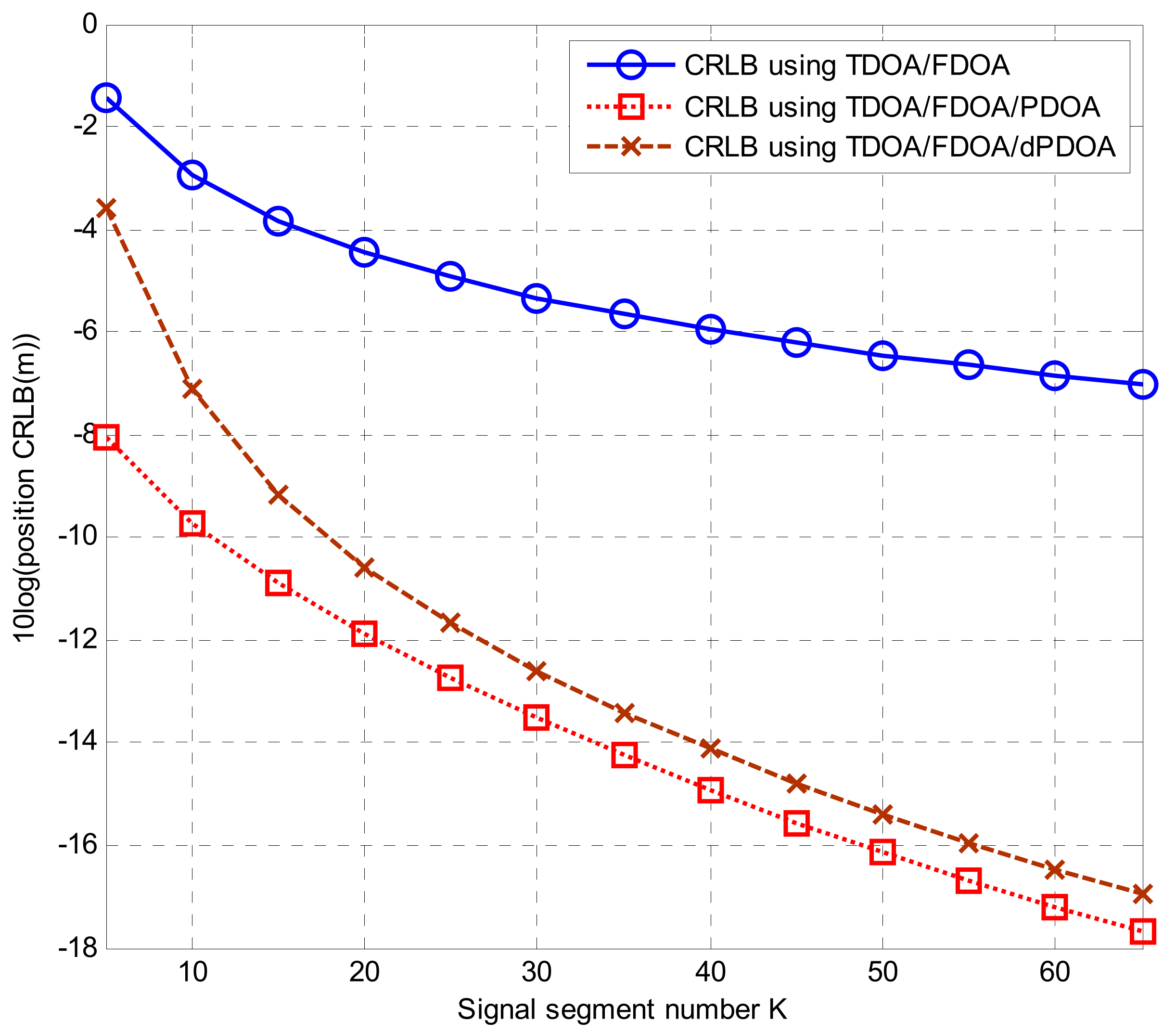
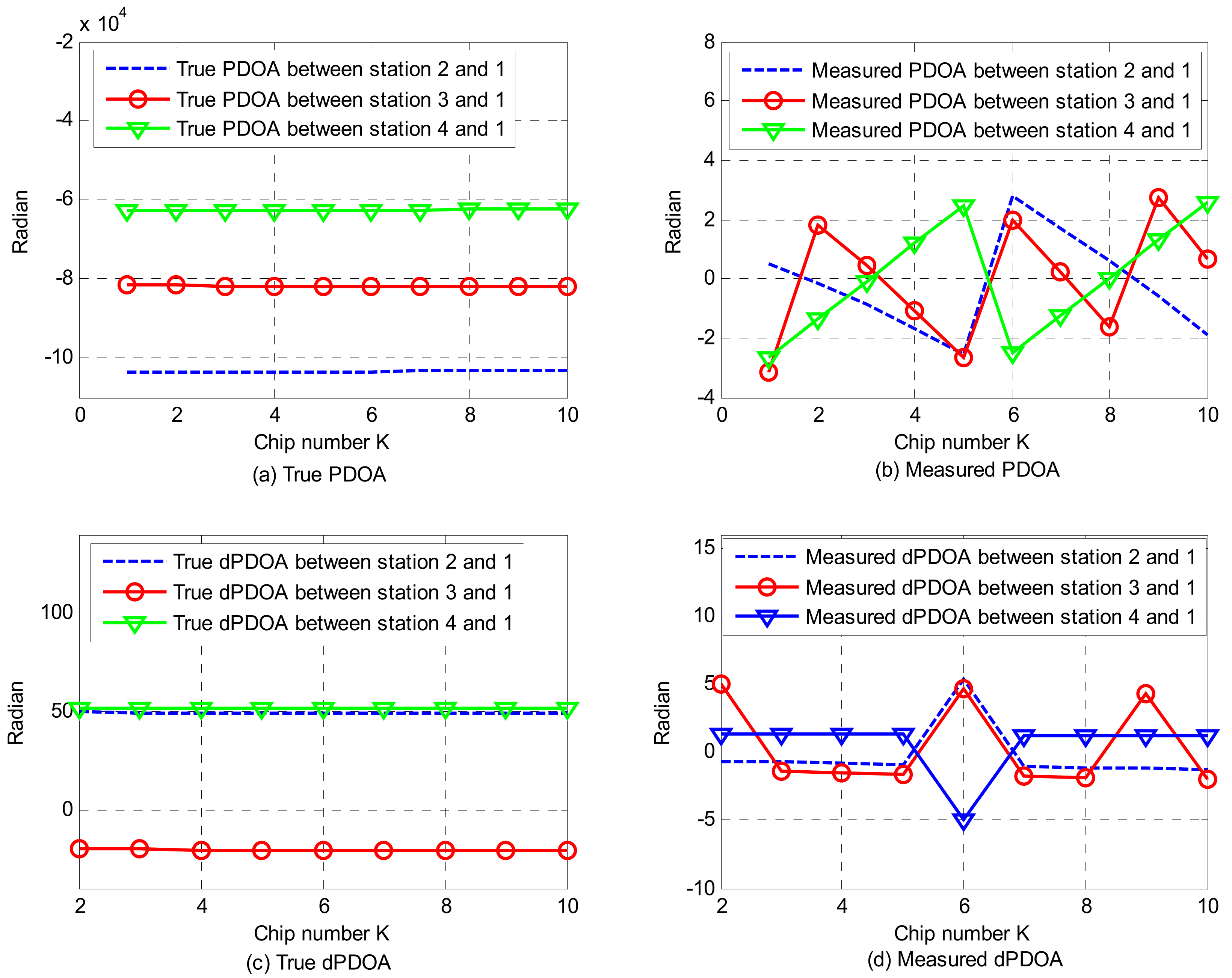
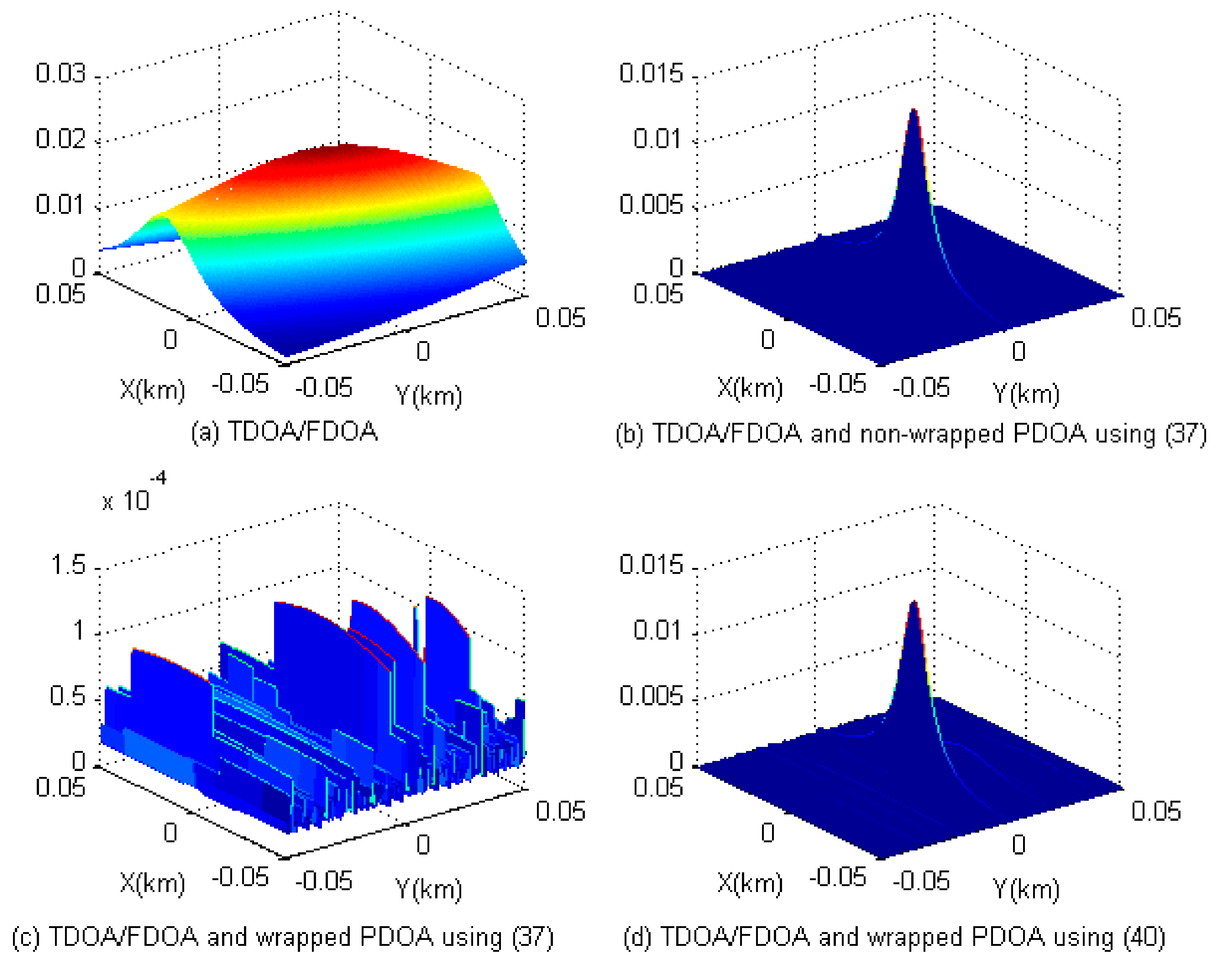
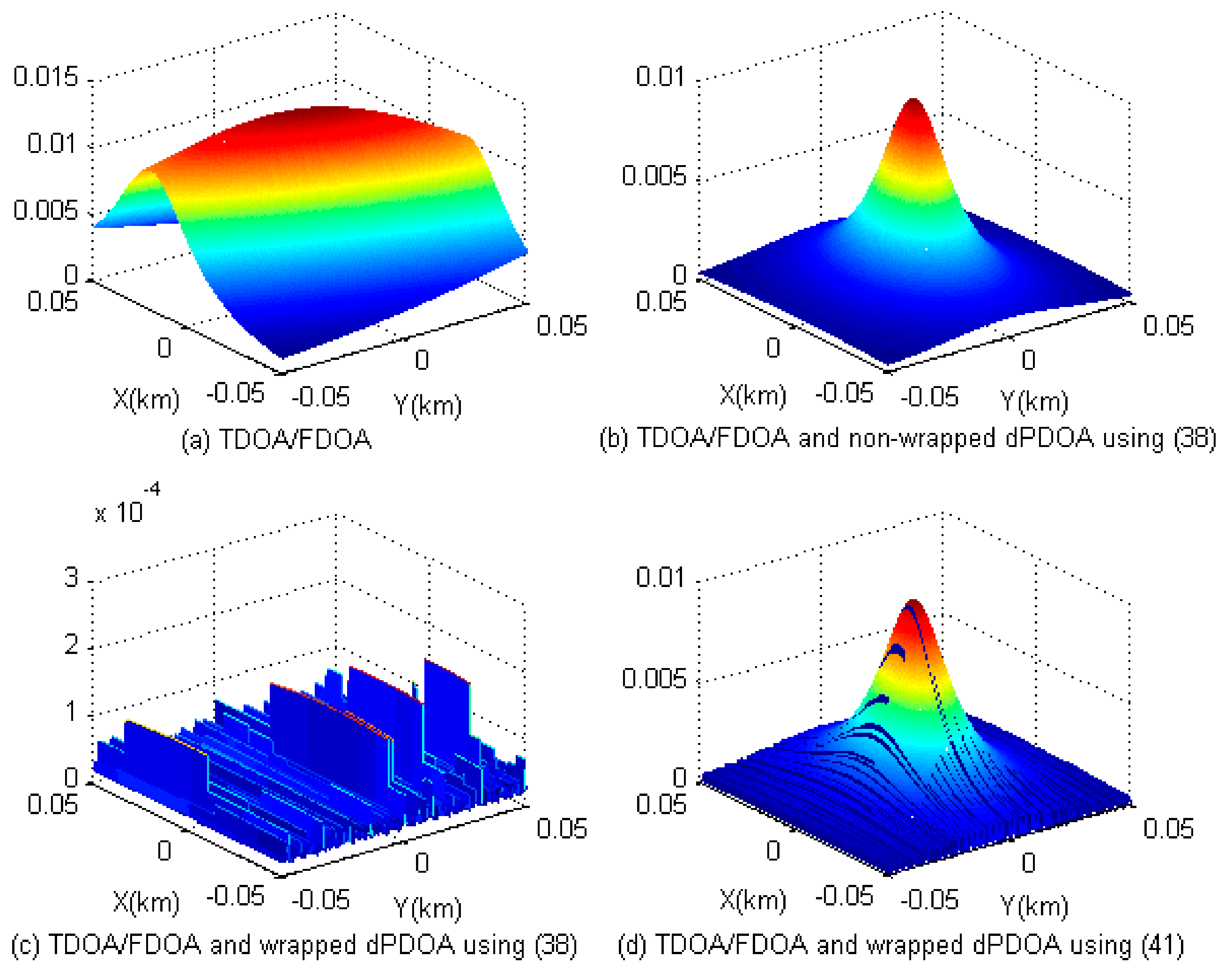
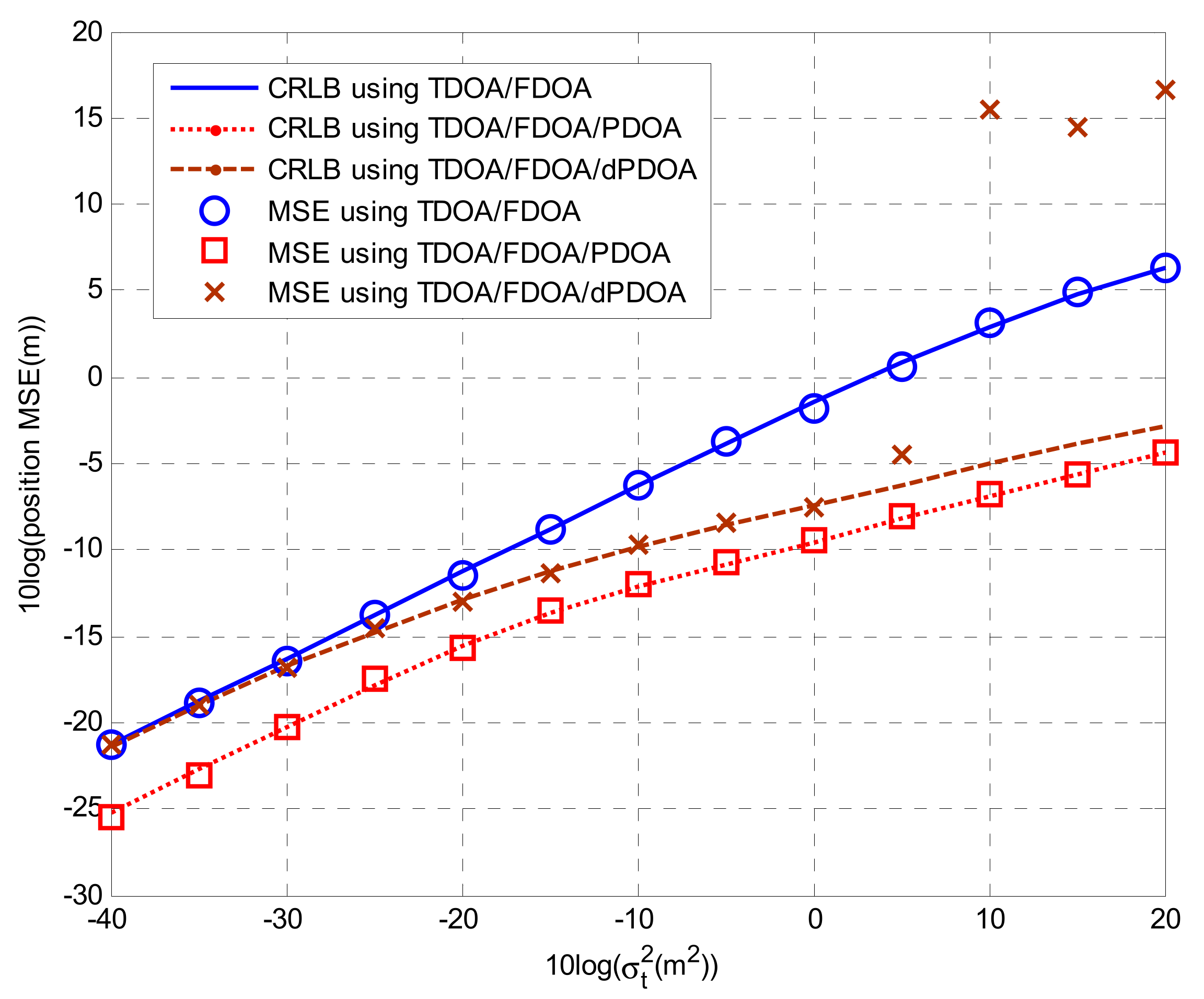
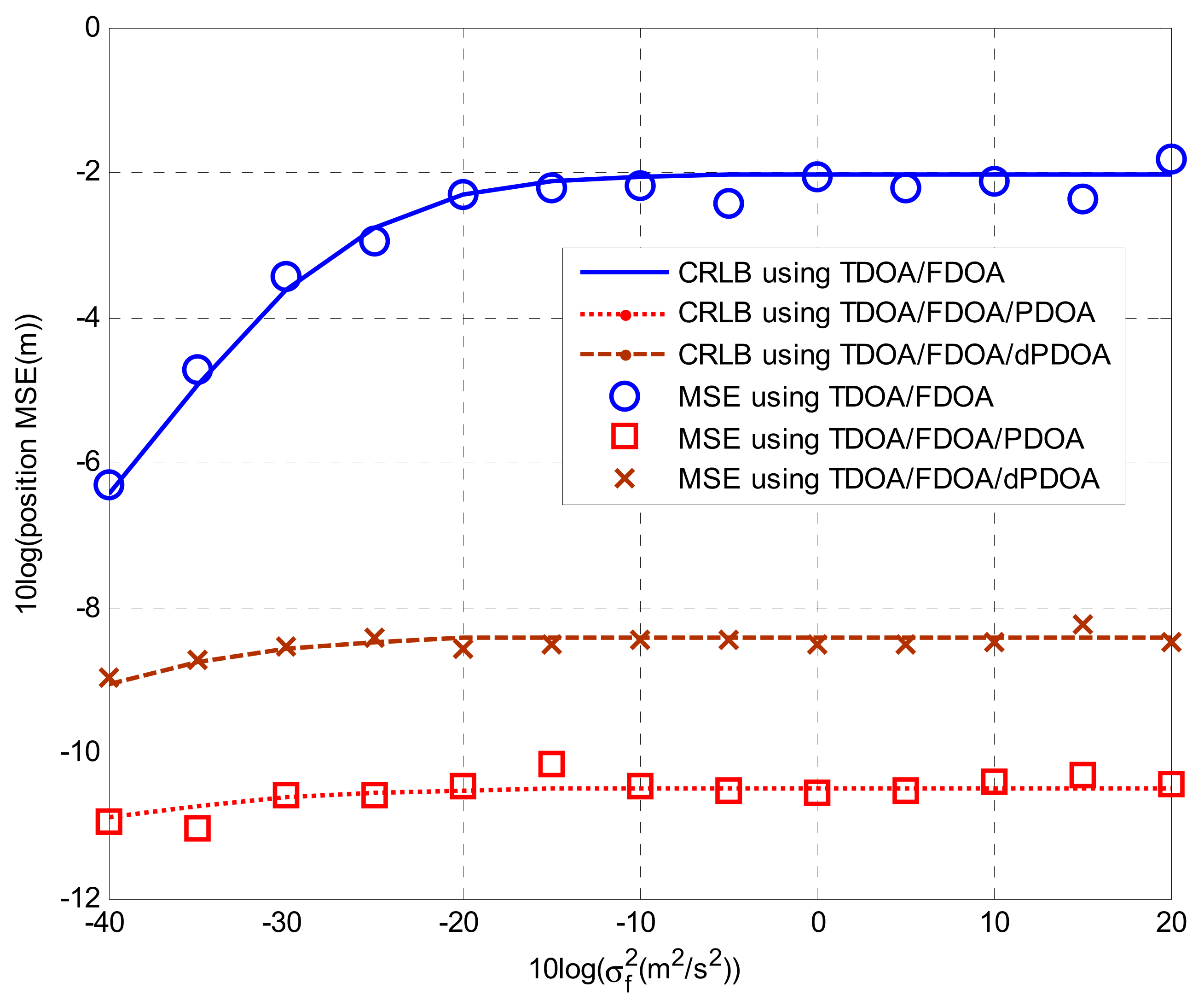
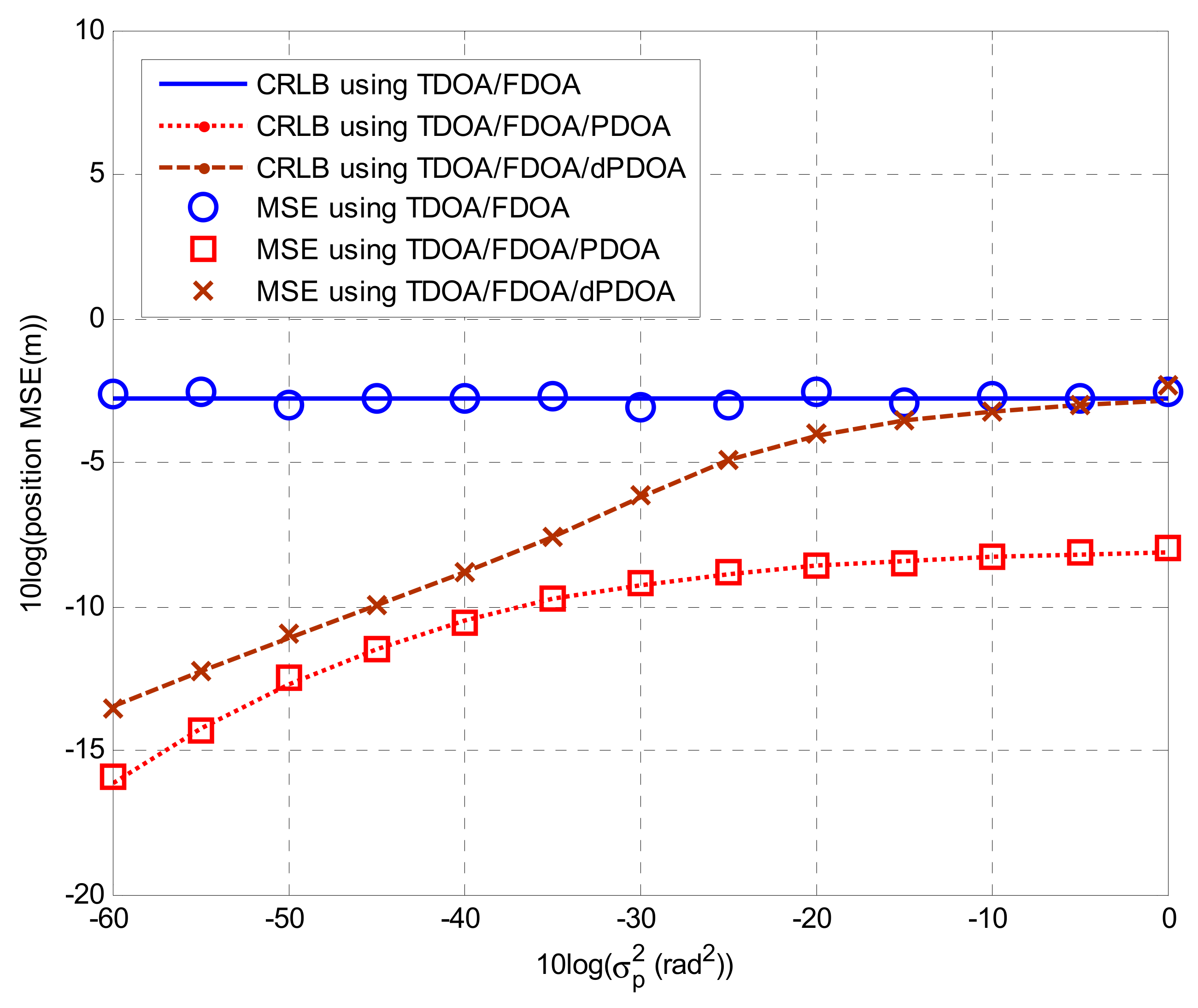
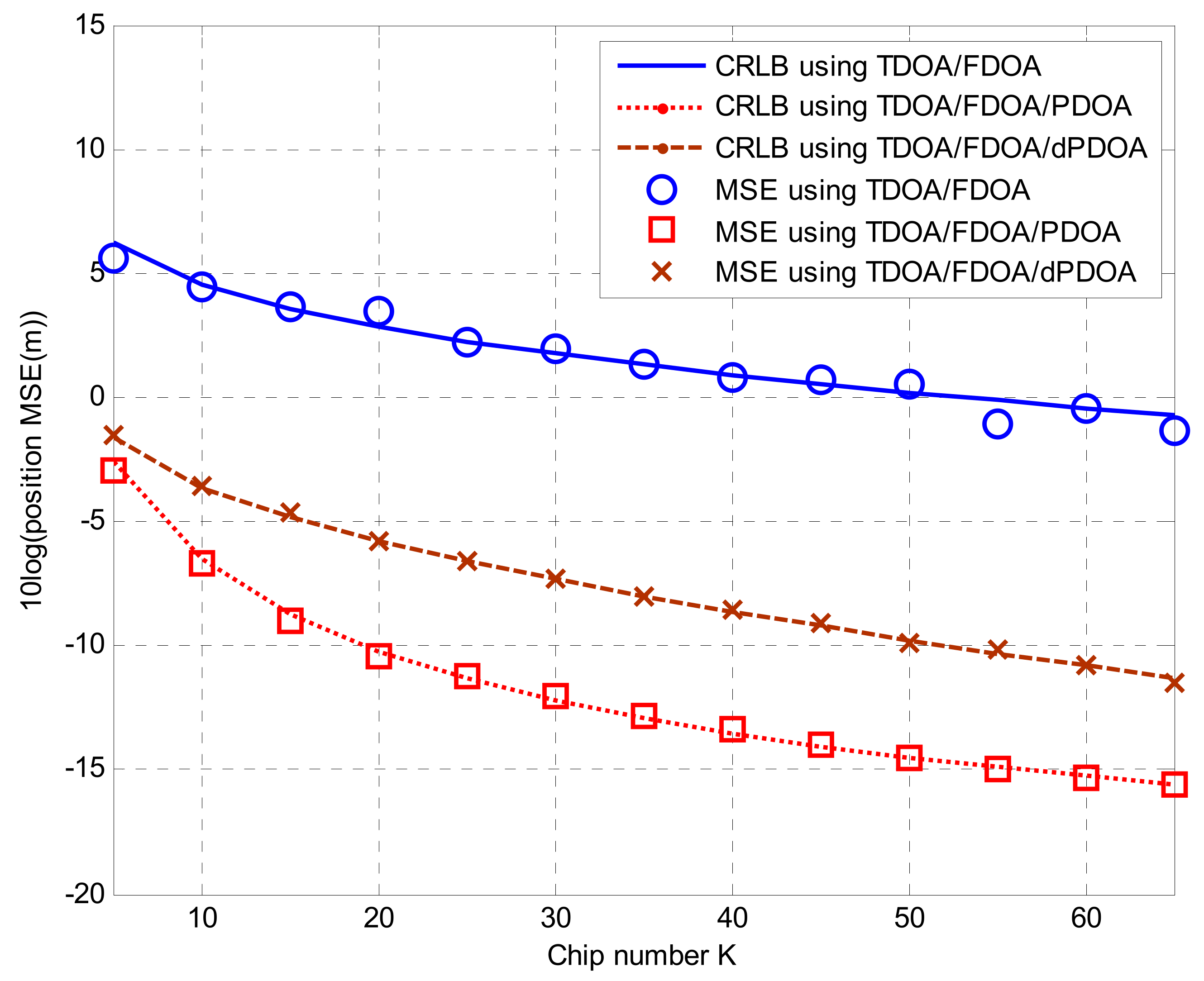
| No. | ||||
|---|---|---|---|---|
| 1 | −10,000 | 0 | 80 | −60 |
| 2 | 6500 | 3500 | −20 | 70 |
| 3 | 3000 | 2000 | 100 | 80 |
| 4 | 0 | 8000 | −50 | −90 |
Disclaimer/Publisher’s Note: The statements, opinions and data contained in all publications are solely those of the individual author(s) and contributor(s) and not of MDPI and/or the editor(s). MDPI and/or the editor(s) disclaim responsibility for any injury to people or property resulting from any ideas, methods, instructions or products referred to in the content. |
© 2023 by the authors. Licensee MDPI, Basel, Switzerland. This article is an open access article distributed under the terms and conditions of the Creative Commons Attribution (CC BY) license (https://creativecommons.org/licenses/by/4.0/).
Share and Cite
Li, J.; Lv, S.; Lv, L.; Wu, S.; Liu, Y.; Nie, J.; Jin, Y.; Wang, C. Joint TDOA, FDOA and PDOA Localization Approaches and Performance Analysis. Remote Sens. 2023, 15, 915. https://doi.org/10.3390/rs15040915
Li J, Lv S, Lv L, Wu S, Liu Y, Nie J, Jin Y, Wang C. Joint TDOA, FDOA and PDOA Localization Approaches and Performance Analysis. Remote Sensing. 2023; 15(4):915. https://doi.org/10.3390/rs15040915
Chicago/Turabian StyleLi, Jinzhou, Shouye Lv, Liujie Lv, Sheng Wu, Yang Liu, Jing Nie, Ying Jin, and Chenglin Wang. 2023. "Joint TDOA, FDOA and PDOA Localization Approaches and Performance Analysis" Remote Sensing 15, no. 4: 915. https://doi.org/10.3390/rs15040915




